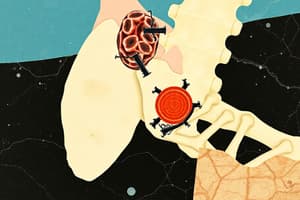Podcast
Questions and Answers
What is the main protein that provides strength to tendons, ligaments, and cartilages?
What is the main protein that provides strength to tendons, ligaments, and cartilages?
- Keratin
- Fibronectin
- Collagen (correct)
- Elastin
What is the primary mineral component found in bone that contributes to its weight-bearing strength?
What is the primary mineral component found in bone that contributes to its weight-bearing strength?
- Hydroxyapatite (correct)
- Calcium carbonate
- Phosphorus oxide
- Calcium sulfate
Which type of bone is characterized as being longer than they are wide with knobby ends?
Which type of bone is characterized as being longer than they are wide with knobby ends?
- Short bones
- Long bones (correct)
- Flat bones
- Irregular bones
What type of bone is nearly cube-shaped and includes most bones of the ankles and wrists?
What type of bone is nearly cube-shaped and includes most bones of the ankles and wrists?
What is the purpose of the periosteum surrounding long bones?
What is the purpose of the periosteum surrounding long bones?
Which part of a long bone is referred to as the shaft?
Which part of a long bone is referred to as the shaft?
Which statement correctly describes flat bones?
Which statement correctly describes flat bones?
Which function of the skeletal system involves safeguarding vital organs such as the brain and heart?
Which function of the skeletal system involves safeguarding vital organs such as the brain and heart?
What type of bone typically has a complex shape and includes bones of the face and vertebral column?
What type of bone typically has a complex shape and includes bones of the face and vertebral column?
Proteoglycans in the extracellular matrix primarily function to:
Proteoglycans in the extracellular matrix primarily function to:
Flashcards
Collagen
Collagen
A tough and rope-like protein that provides strength to tendons, ligaments, and cartilages.
Calcium Phosphate Crystals
Calcium Phosphate Crystals
A mineral component in bones that gives them compression strength.
Proteoglycans
Proteoglycans
Large molecules consisting of polysaccharides attached to core proteins.
Long Bone
Long Bone
Signup and view all the flashcards
Short Bone
Short Bone
Signup and view all the flashcards
Flat Bone
Flat Bone
Signup and view all the flashcards
Irregular Bone
Irregular Bone
Signup and view all the flashcards
Periosteum
Periosteum
Signup and view all the flashcards
Endosteum
Endosteum
Signup and view all the flashcards
Diaphysis
Diaphysis
Signup and view all the flashcards
Study Notes
Extracellular Matrix
- Crucial for bone structure, including cartilage, tendons, ligaments, and bones.
- Collagen: Tough, rope-like protein providing strength (like steel in concrete).
- Mineral component: Provides compression strength (like concrete).
- Hydroxyapatite: Calcium phosphate crystals forming most of bone's mineral content.
- Proteoglycans: Large molecules with polysaccharides attached to proteins.
- Proteoglycan aggregates act like a "tree" structure, retaining water.
Classification of Bones
-
Long Bones: Longer than wide, knobby ends for articulation.
- Hollow shafts, solid ends.
- Articular cartilage (hyaline cartilage) on ends for joints.
- Curved structure for strength.
- Examples: Arms, legs, fingers, toes.
- Periosteum: Dense connective tissue covering the diaphysis (central shaft).
- Endosteum: Thin epithelial membrane lining the medullary cavity.
- Diaphysis: Central shaft of a long bone.
- Epiphysis: Head of each end of a long bone.
- Medullary Cavity: Marrow cavity containing yellow marrow.
-
Short Bones: Equal length and width, nearly cube-shaped.
- Example: Ankle and wrist bones.
-
Flat Bones: Thin, providing protection and muscle attachment sites.
- Example: Skull, sternum, ribs.
-
Irregular Bones: Complex shapes.
- Example: Face bones, vertebrae.
Functions of the Skeletal System
- Support: Supports and stabilizes soft tissues (muscles, blood vessels, nerves, fat, skin).
- Protection: Protects vital organs (brain, spinal cord, heart, lungs).
- Movement: Facilitates movement by providing attachments for muscles, acting as levers.
- Blood Cell Production: Hemopoiesis occurs in red bone marrow (a connective tissue within bone).
- Produces red blood cells, white blood cells, and platelets.
- Storage: Stores mineral salts (especially calcium and phosphorus) and fats.
- Yellow bone marrow: Primarily composed of adipose cells storing triglycerides (fats).
- Red marrow transforms to yellow marrow with age.
Studying That Suits You
Use AI to generate personalized quizzes and flashcards to suit your learning preferences.




